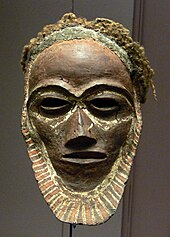Skull mask
A skull mask is used to describe a mask - like human skull from which all bones have been removed except for the facial skull (with the os nasale and os lacrimale ), parts of the upper jaw ( maxilla ), the frontal bone ( os frontale ) and the temporal bones ( os zygomaticum ). Skull masks are known from prehistoric and early historical Europe and Papua New Guinea.
Europe
The best-known European specimens come from the early Neolithic , such as the skull mask of an adult from a settlement pit of the linear ceramic earthworks in Eisleben ( Saxony-Anhalt ), the skull mask of a 20-25 year old woman from the end-Neolithic settlement of Hunte I am Dümmer ( Lower Saxony ) or the mask from the skull of a young woman from Michelsberg culture from the Bruchsal -Aue settlement ( Baden-Württemberg ). From the Iron Age one comes mittellatènezeitliche skull mask with holes on the frontal bone from a settlement pit near Clouds (near Koblenz) ( Rheinland-Pfalz ) that dated to the 3rd century BC..
In 2009 there was an exhibition in Vienna entitled We are Mask , which featured some of the skull masks . A Neolithic skull mask from Aue in the Karlsruhe district is in the holdings of the State Office for Monument Preservation Esslingen am Neckar, others are in the holdings of the monument protection offices of Saxony-Anhalt and Lower Saxony.
Papua New Guinea

In New Britain ( Papua New Guinea ), skull masks were used by the Tolai people , although little is known about their spiritual background. These skull masks were made from facial skulls that were over-modeled with a putty mass of clay and the juice of the fruits of the Parinarium bush. The lower jaws of the skulls were reattached with the putty. On the front, eyes, nose and mouth have been sculpted and given a color. Many masks wear hairstyles made from plant fibers with decorative elements made from feathers. At the beginning of the 20th century, these masks were so popular with collectors that the Tolai are said to have made them on request.
literature
- Axel von Berg: The skull cult in the Celtic Iron Age. In: Alfried Wieczorek , Wilfried Rosendahl, Andreas Schlothauer (eds.): The cult around head and skull. Interdisciplinary considerations on a human issue. (= Colloquium volume on the occasion of the exhibition "Skull Cult - Head and Skull in the Cultural History of Man" in the Reiss-Engelhorn-Museums Mannheim). Verlag Regionalkultur, Heidelberg et al. 2012, ISBN 978-3-89735-769-3 , pp. 75–81.
- Antje Keim: Skull masks from New Britain - evidence of a past world of faith. In: Alfried Wieczorek, Wilfried Rosendahl, Andreas Schlothauer (eds.): The cult around head and skull. Interdisciplinary considerations on a human issue. (= Colloquium volume on the occasion of the exhibition "Skull Cult - Head and Skull in the Cultural History of Man" in the Reiss-Engelhorn-Museums Mannheim). Verlag Regionalkultur, Heidelberg et al. 2012, ISBN 978-3-89735-769-3 , pp. 171–178.
- Jörg Orscheidt: Skull cult in the Neolithic. In: Alfried Wieczorek, Wilfried Rosendahl, Andreas Schlothauer (eds.): The cult around head and skull. Interdisciplinary considerations on a human issue. (= Colloquium volume on the occasion of the exhibition "Skull Cult - Head and Skull in the Cultural History of Man" in the Reiss-Engelhorn-Museums Mannheim). Verlag Regionalkultur, Heidelberg et al. 2012, ISBN 978-3-89735-769-3 , pp. 53-61, 362.
- Reena Perschke: Head and Body - The "Skull Cult" in the Near Eastern Neolithic. In: Nils Müller-Scheeßel (Ed.): Irregular "burials in prehistory: Norm, ritual, punishment ...? (= Files of the international conference in Frankfurt a. M. from February 3rd to 5th, 2012). Habelt , Bonn 2013, ISBN 978-3-7749-3862-5 , pp. 95-110.
- Jörg Scheidt, Marc Hellstern: An over-modeled skull of the Dayak. In: K. Grundmann, Gerhard Aumüller (ed.): The Marburg Medical History Museum - Museum Anatomicum. (= Marburg city writings on history and culture. Volume 98). Marburg 2012, pp. 84–86
Web links
- Michel Rahnefeld: High-tech methods open up new perspectives on Celtic skull finds . In: Arge-Grabenstetten.de, March 27, 2011
Individual evidence
- ↑ a b c d Jörg Orscheidt: Skull cult in the Neolithic . In: Alfried Wieczorek, Wilfried Rosendahl (ed.): Skull cult - head and skull in the cultural history of man . Schnell + Steiner, Regensburg 2011, ISBN 978-3-7954-2454-1 , p. 53-61, 362 .
- ↑ Wolf-Rüdiger Teegen: Skull mask from the Hunte am Dümmer settlement on academia.edu, accessed on February 16, 2014. (PDF)
- ↑ Axel von Berg: The skull cult in the Celtic Iron Age . In: Alfried Wieczorek, Wilfried Rosendahl (ed.): Skull cult - head and skull in the cultural history of man . Schnell + Steiner, Regensburg 2011, ISBN 978-3-7954-2454-1 , p. 75-81 .
- ↑ The longing for the other face on derstandard.at, accessed on February 16, 2014.
- ^ A b Exhibition Museum für Völkerkunde Hamburg
- ↑ Antje Kelm: Skull masks from New Britain . In: Alfried Wieczorek, Wilfried Rosendahl (ed.): Skull cult - head and skull in the cultural history of man . Schnell + Steiner, Regensburg 2011, ISBN 978-3-7954-2454-1 , p. 171-177, 380 .